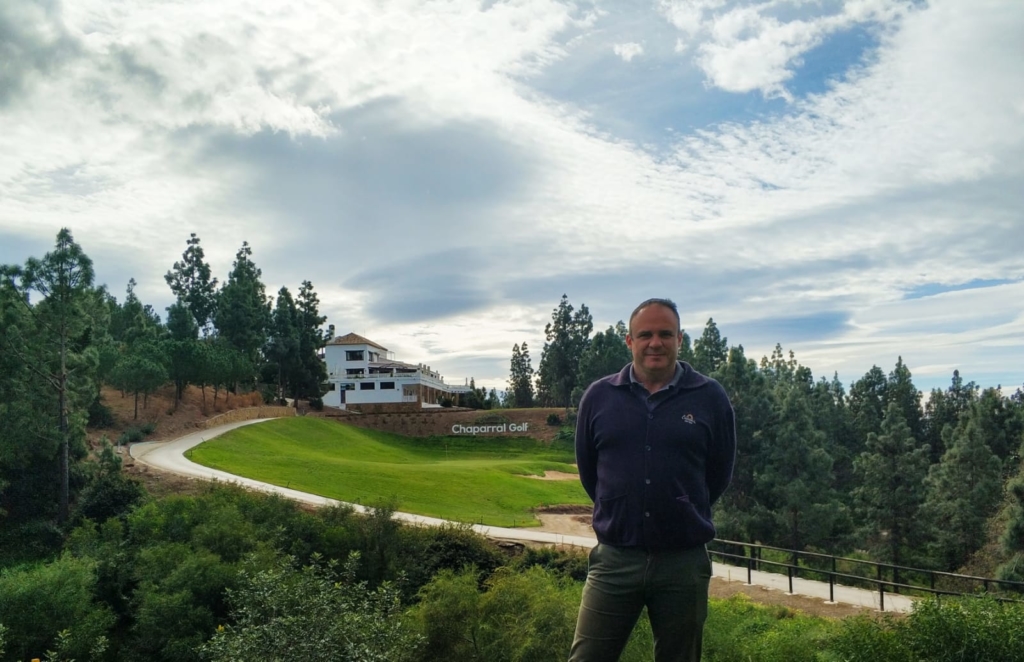Interview with Jaime Mamolar, Head Greenkeeper at Chaparral Golf Club
Jaime Mamolar, Head Greenkeeper at Chaparral Golf Club, is a Forestry Technical Engineer and Mountain Engineer with a Master in Green keeping (EADE). After finishing his studies, he started working for Grupo Eulen, doing technical maintenance studies on soccer fields and on golf courses in different regions of Andalusia, Melilla and the Canary Islands.
With this experience, he started working as a Green keeper for Chaparral Golf in April 2018.
- What motivated you to a professional career in agronomy, and more specifically to the maintenance of golf courses?
Since I was a child I lived in an agro forestry environment and I always liked the contact with nature, which led me to opt for Agronomic Engineering. I discovered the world of golf as a player and I found the maintenance and protocol work on the course so interesting that I specialized in green keeping. In this type of agronomy, most of the technical aspects of engineering can be developed.
Chaparral Golf Club offered me to become part of an exciting project and I went to the Costa del Sol to get to know the course, the management and maintenance team and I thereafter decided to join the club as their Green keeper.
- What has been the evolution of the course this last year?
Due to the plant growth cycle itself, the course is very changeable throughout the year. But in general terms, if we analyze each of the areas of play, the quality has clearly improved. We have done improved work in the construction and levelling of the majority of the tees, changed the fore greens, cleaned and cleared all the areas of ball drop and changed the sand in all the bunkers.
This first year I observed and studied the specific problems and needs arising during one vegetative cycle while improving the general condition of the course. Many areas that were unplayable have now been adapted to play, the plant density has increased, the mowing has been intensified, bunkers have been conditioned, etc. The substrate on the greens, the density of Agrostis and its health status have improved. Once a good development base has been established, the work now is to increase the speed and receptivity.
- How is the day-to-day life of a Greenkeeper in a Pay & Play course like Chaparral?
The golf course has a wide surface and differentiated areas, which means that each day we have about 20 ongoing tasks of different maintenance work and reforms. Therefore, the organization of time in this work is fundamental. I usually divide the time into three blocks: the organization of resources, the inspection of the course and analysis of the clients´ satisfaction through the Management of the Club.
Throughout the day new challenges and needs arise, which means that the programming follows the original plan with a daily adjustment and update.
- What improvements do you have planned for 2019?
The maintenance program is divided and executed on the different areas of play, not only with the focus on maintaining, but also the improvement of each one of the areas. This year our main focus are on three elements:
- We will specifically work the fringes of greens on to homogenize and pay special and put in optimal condition and all holes and with a height of no more than 8 mm.
- Bunkers: improve the drainage and water collection systems to avoid contamination of the sand.
- Paths: Although some improvements were made in 2018, during 2019 we will continue with the improvements regarding protection and security elements.
- The course of Chaparral is located in a special place, in a protected area of pine forest, which makes it a unique spot on the Costa del Sol. Do you have any specific maintenance and conservation plan?
For us it´s essential to maintain the vegetation that provides this course with such a valuable environment, where the protagonist is undoubtedly the pine tree. My main objective is to maintain this type of vegetation in a state of development and optimal health and one of our main tasks is the control of the non-native vegetation interfering with the protected, local species of the area. This work of clearance also improves the playability of the course.
- What is your strategic plan in course maintenance for 2019? Are we going to see more improvements and investments on the course?
The Strategic Maintenance Plan is aimed at the following fundamental aspects:
- Resolution of ”old problems” that affect the state of the grass development: soil salinization and cyclical diseases and pests.
- Increase the quality of our greens and fringe of greens, favouring the development of Agrostis grass against invasive species.
- Maintain the quality of the tees, through a special schedule of planting, turfing and fertilization and to continue with the construction and reformation of new tees.
The main investments to be executed are:
- Acquisition of equipment for measuring physical parameters of the soil.
- Construction of an Agrostis green house of 1,200 m2 to obtain turf and to continue reforming all the fringes before the end of the year and several greens.
- Conclusion of the Tees Plan, building three new levels and reforming three others.
- Reform of drainages and water collection systems in bunkers suffering from problems of this type.
- Construction of about 150 meters of path and continue investing in the safety and protection systems.


